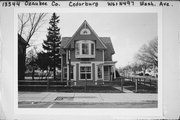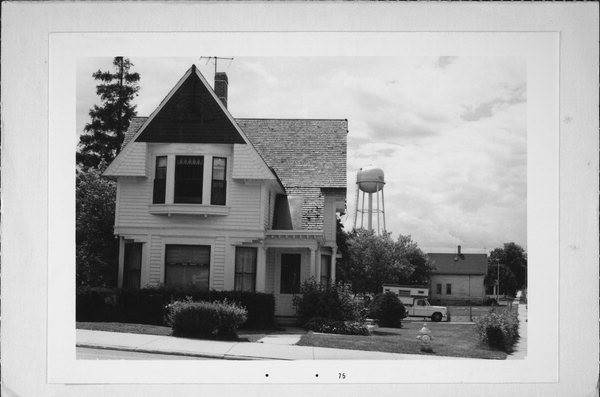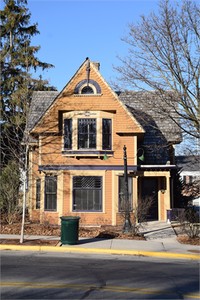Charles Wirth Residence
Introduction
Text-to-speech Audio
Here is another house that hosted another influential individual here in Cedarburg. Charles Wirth is another person who has influenced this community. By showing his contributions to the many roles he had during his life, we can get a clear picture why he was so influential here as well as another great Cedarburg citizen.
Images

Note Cedarburg's Water Tower In The Background.

The Charles Wirth Residence Today.

Backstory and Context
Text-to-speech Audio
If you remember the J.P. Wirth Building earlier in the tour. J.P. Wirth owned a business here, but that is not the whole story. His son, Charles Wirth, was born on November 17th, 1849, after Wisconsin became a state and became part of the United States. Unlike the other individuals on this tour who were born in Germany or other American cities and towns, Charles is a real Cedarburger born in Cedarburg. Once Charles became older, his father would teach Charles how to be a shoemaker while juggling his schooling and education. Later in his life, Charles would start a general store of his own with his brother G.H. Wirth. But Charles was not just a businessman; he was also a banker. Later in the tour, we will analyze the Cedarburg State Bank building. But for now, we will focus on what Charles did there.
When Cedarburg was founded in the late 1840s, there was almost no mention of a locally owned state bank. However, once Cedarburg developed into a booming population and the business scene. Financial stability to keep the businesses up and running would be crucial to that goal. Therefore, state banks started to pop up in the area once Cedarburg developed into the late nineteenth-century and early twentieth-century. This included Grafton, Port Washington, Mequon, and Thiensville. The Cedarburg State Bank would be built and established in 1908; as Charles grew older and older, he would become president of the bank in 1909. Charles, during his tenure, would attend to the financial needs of business owners and citizens alike. The way he created the bank was actually out of creating a mortgage and loan office he owned himself, which, as a result, led to the foundation of the bank. He also decided to step down from his business to become the bank's president. Charles would be the president of the bank until his death.
Again, however, he was not the same as just being a bank president. Charles would also be a Justice Of The Peace for many years, following and upholding the law. He was so influential here that locals would give him the nickname "Judge" due to his impact. Due to his role as a bank president, he was also the treasurer of the Milwaukee River Canning Company, handling their business ventures in the area. In addition, he was a member of the Cedarburg Benevolent Society, known as the Cedarburg Advancement Association (CAA). This association was established in 1902 when Wirth and other notable individuals of Cedarburg sought to promote the town and its businesses to attract incoming tourists and regular folks who lived in the area and promote the town. It would act like the Cedarburg Chamber Of Commerce today; they would also consult with other private firms and other government agencies to improve the town's roads and other infrastructure. Wirth attended these meetings and made another significant impact on the community. He would become president of the association as well.
His personal life was also fascinating. He would marry Mary Goetz in 1871 and would have five children. Sadly though, two of his sons died while they were infants. Another one of his sons died while training to become a minister. No one knows the cause, but he could have died from disease or an accident; we don't know. Then, in the late spring and early summer of 1927, Charles was reading a newspaper when he suddenly suffered and died from a stroke. He was 77 years old at the time of his death. His death could have been the cause of his multiple roles, probably adding stress to his life that affecting his health. He would be buried in Zer Rhue cemetery on June 29th, 1927; he is still buried there today. On the other hand, his house had a fascinating history as well. When it was established in 1890, it was inspired by a framed Queen Anne style that features a beautiful and original revival detail. It is still preserved today as a historic home here along Washington Avenue.
Sources
A Walk Through Yesterday: In Cedarburg Wisconsin. 2005.
Stumpf, Glenn, Everix, Kathy. Charles Christlieb "C.C." Wirth, Find A Grave. February 26th 2016. Accessed May 19th 2022. https://www.findagrave.com/memorial/61340159/charles-christlieb-wirth.
Gierach, Ryan. Cedarburg: A History Set In Stone. The Making Of America. Charleston, South Carolina. Arcadia Publishing, 2003. 110.
Wisconsin Historical Society, Wisconsin Architecture and History Inventory, Charles Wirth Residence, Cedarburg, Ozaukee County, Wisconsin, 13344.
https://www.wisconsinhistory.org/Records/Property/HI13344
https://www.wisconsinhistory.org/Records/Property/HI13344
https://www.wisconsinhistory.org/Records/Property/HI13344
